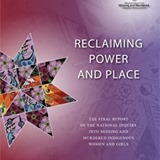 Sorry for my delay in posting.
Sorry for my delay in posting.
Chapter 3 was a relatively easy read. It starts with a reminder that Indigenous stories lay out principles of respect, reciprocity and interconnectedness. These themes keep repeating for good measure, lest we forget.
Human rights abuses are manifest in the lack of services and lack of protections afforded Indigenous women, girls, and gender-diverse. This chapter makes the simple point that a Human Rights framework can be used as part of the strategy for decolonization.
International Human Rights covenants are enforceable as “soft law” meaning that countries who sign are subject to monitoring by the United Nations. Canada has ratified seven core international instruments which create a pathway to justice for Indigenous people.
One example is the Declaration on the Elimination of Violence Against Women which recognizes three categories: (1) violence by the state, (2) violence in society such as trafficking,and (3) violence within the family unit. Member countries are urged to combat violence, provide services to victims, and work on prevention.
Another example is the United Nations Declaration of the Rights of Indigenous Peoples. This proclaims the collective and human rights of Indigenous peoples including the right to self-determination; the right to maintain distinct political, legal, economic, social, and cultural institutions; the right to lands , territories, and resources traditionally owned, and guaranteed protection of women and children from all forms of violence and discrimination.
Within Canada, federal and provincial legislation prohibits discrimination on 13 grounds including: race, national or ethnic origin, colour, religion, age, sex, sexual orientation, gender identity or expression, marital status, family status, genetic characteristics, disability, and previous convictions that have been pardoned.
In summary, we must avoid a one-dimensional approach. Individual rights and collective Indigenous rights overlap. We can transform encounters that endanger Indigenous women into ones that protect them. The present crisis has taken centuries to develop. We must understand the past in order to change the future.
Human rights frameworks are important tools to begin the conversation.

